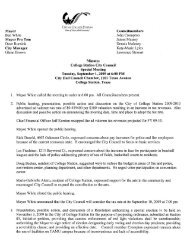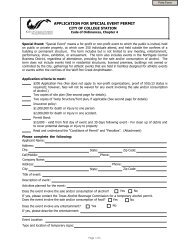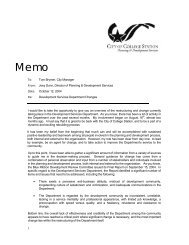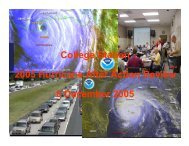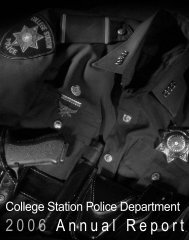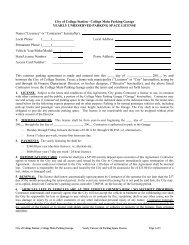standard operating procedure college station fire department
standard operating procedure college station fire department
standard operating procedure college station fire department
You also want an ePaper? Increase the reach of your titles
YUMPU automatically turns print PDFs into web optimized ePapers that Google loves.
SUBJECT: Rapid Intervention Teams POLICY: 300.1.11<br />
CATEGORY: Operations PAGE: 2 of 4<br />
Instructions/Procedures<br />
Incident Command Shall:<br />
a. Designate a RIT as soon as sufficient personnel are on the scene to provide an initial attack and<br />
he/she determines a potential hazard exists for Fire Department personnel <strong>operating</strong> at the scene.<br />
b. Continue to evaluate the situation and the risk to personnel and shall provide for one or more<br />
RITs as dictated by the incident or situation.<br />
c. Maintain a minimum of one RIT in position at designated area until Command determines the<br />
situation has been stabilized and the need for rapid intervention no longer exists. Should the need<br />
arise, Command may reassign RITs to other duties on the <strong>fire</strong>-ground, but reassignment shall not<br />
occur unless Command has provided for another non-fatigued company to replace the original<br />
RIT.<br />
d. Designate multiple RITs for incidents that cover large geographic areas. At high-rise incidents, it<br />
may be necessary for Command to assign a RIT to the Staging/Resource sector inside the<br />
structure.<br />
e. Whenever RIT is deployed it should be replaced as soon as possible to back up the crews<br />
involved in a rescue operation.<br />
f. RITs can be used for appropriate assignments after all crews are out of danger, PARs have been<br />
obtained, and an IDLH atmosphere no longer exists. Command may assign this company as a<br />
relief unit and rotate them with interior companies.<br />
Rapid Intervention Teams shall:<br />
a. Be designated by Command and shall assemble with full protective gear, including SCBA, rescue<br />
equipment (axe, haligan tool, hand lights, Thermal Imager, lifeline, extra air bottles and<br />
equalization hose, etc.), and other related equipment at a position in the immediate proximity of<br />
the <strong>fire</strong> personnel entry point. RIT shall remain in visual or verbal contact (via radio) with<br />
Command at all times while awaiting assignment.<br />
b. Upon assignment of RIT responsibilities, the RIT leader should obtain a detailed briefing from<br />
the Incident Commander or the RIT they are relieving on the status and location of all assigned<br />
companies.<br />
c. The RIT officer shall monitor and maintain radio communications with the IC and/or <strong>fire</strong> crews<br />
as needed.<br />
d. Begin a visual size-up of the building and any endangered exposures and available escape routes.<br />
In some situations hose-lines may need to be pre-deployed. RIT companies should assess the<br />
need for other access points to provide for egress, rescue, and ventilation. Forcible entry may be<br />
necessary. When companies are <strong>operating</strong> on floors above ground, the RIT should consider prepositioning<br />
ground ladders to allow for emergency egress and rescue.



